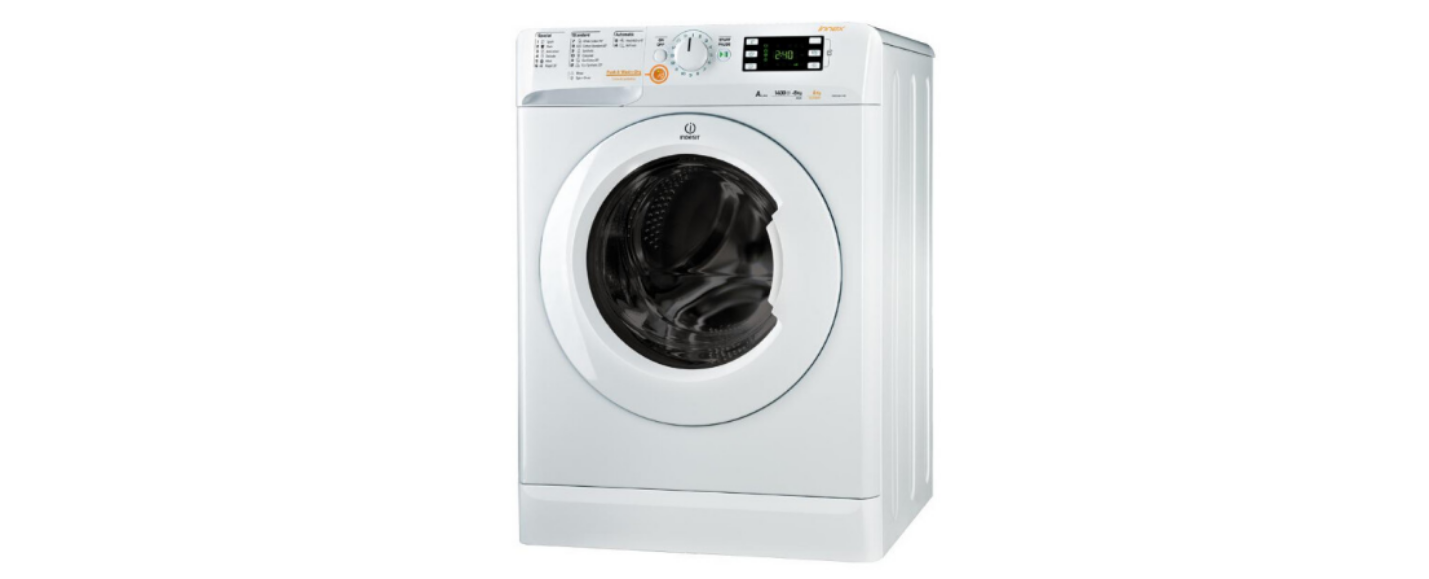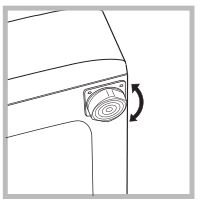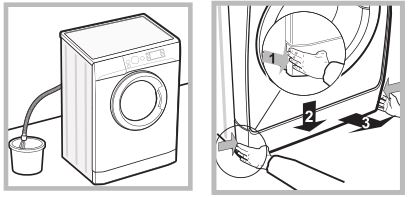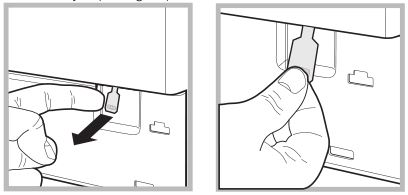 INDESIT Washer-Dryer Instruction Manual
INDESIT Washer-Dryer Instruction Manual

INDESIT Washer-Dryer Instruction Manual
Installation
! This instruction manual should be kept in a safe place for future reference. If the washer-dryer is sold, transferred or moved, make sure that the instruction manual remains with the machine so that the new owner is able to familiarise himself/herself with its operation and features.
! Read these instructions carefully: they contain vital information relating to the safe installation and operation of the appliance.
Unpacking and levelling
Unpacking
- Remove the washer-dryer from its packaging.
- Make sure that the washer-dryer has not been damaged during the transportation process. If it has been damaged, contact the retailer and do not proceed any further with the installation process.
- Remove the 4 protective screws (used during transportation) and the rubber washer with the corresponding spacer, located on the rear part of the appliance (see figure).

- Close off the holes using the plastic plugs provided.
- Keep all the parts in a safe place: you will need them again if the washer-dryer needs to be moved to another location.
! Packaging materials should not be used as toys for children.
Levelling
- Install the washer-dryer on a flat sturdy floor, without resting it up against walls, furniture cabinets or anything else.
- If the floor is not perfectly level , compensate for any unevenness by tightening or loosening the adjustable front feet (see figure); the angle of inclination, measured in relation to the worktop, must not exceed 2°. Levelling the machine correctly will provide it with stability, help to avoid vibrations and excessive noise and prevent it from shifting while it is operating. If it is placed on carpet or a rug, adjust the feet in such a way as to allow a sufficient ventilation space underneath the washer-dryer.

Connecting the electricity and water supplies
Connecting the water inlet hose
- Connect the supply pipe by screwing it to a cold water tap using a ¾ gas threaded connection (see figure). Before performing the connection, allow the water to run freely until it is perfectly clear.

- Connect the inlet hose to the washer-dryer by screwing it onto the corresponding water inlet of the appliance, which is situated on the top right-hand side of the rear part of the appliance (see figure).
- Make sure that the hose is not folded over or bent.
! The water pressure at the tap must fall within the values indicated in the Technical details table (see next page).
! If the inlet hose is not long enough, contact a specialised shop or an authorised technician.
! Never use second-hand hoses.
! Use the ones supplied with the machine.
Connecting the drain hose
Connect the drain hose, without bending it, to a drainage duct or a wall drain located at a height between 65 and 100 cm from the floor; alternatively, rest it on the side of a washbasin or bathtub, fastening the duct supplied to the tap (see figure). The free end of the hose should not be underwater.
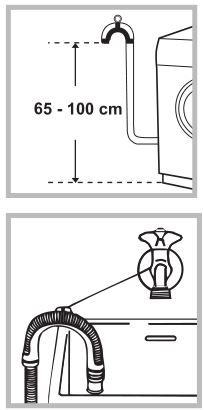
! We advise against the use of hose extensions; if it is absolutely necessary, the extension must have the same diameter as the original hose and must not exceed 150 cm in length.
Electrical connections
Before plugging the appliance into the electricity socket, make sure that:
- the socket is earthed and complies with all applicable laws;
- the socket is able to withstand the maximum power load of the appliance as indicated in the Technical data table (see opposite);
- the power supply voltage falls within the values indicated in the Technical data table (see opposite);
- the socket is compatible with the plug of the washer-dryer. If this is not the case, replace the socket or the plug.
! The washer-dryer must not be installed outdoors, even in covered areas. It is extremely dangerous to leave the appliance exposed to rain, storms and other weather conditions.
! When the washer-dryer has been installed, the electricity socket must be within easy reach.
! Do not use extension cords or multiple sockets.
! The cable should not be bent or compressed.
! The power supply cable must only be replaced by authorised technicians.
Warning! The company shall not be held responsible in the event that these regulations are not respected.
The first wash cycle
Once the appliance has been installed, and before you use it for the first time, run a wash cycle with detergent and no laundry, using the wash cycle “Auto Clean” (see “Cleaning the washer-dryer”).

Care and maintenance
Cutting off the water and electricity supplies
- Turn off the water tap after every wash cycle. This will limit wear on the hydraulic system inside the washer-dryer and help to prevent leaks.
- Unplug the washer-dryer when cleaning it and during all maintenance work.
Cleaning the washer-dryer
- The outer parts and rubber components of the appliance can be cleaned using a soft cloth soaked in lukewarm soapy water. Do not use solvents or abrasives.
- The washer-dryer has a “Auto Clean” programme for its internal parts that must be run with no load in the drum.
For maximum performance you may want to use either the detergent (i.e. a quantity 10% the quantity specified for lightly-soiled garments) or special additives to clean the washer-dryer. We recommend running a cleaning programme every 40 wash cycles. To start the programme press buttons A and B simultaneously for 5 seconds (see figure). The programme will start automatically and will last approximately 70 minutes. To stop the cycle press the START/PAUSE button.
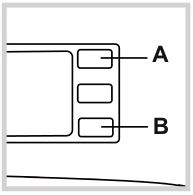
Cleaning the detergent dispenser drawer

Caring for the door and drum of your appliance
- Always leave the porthole door ajar in order to prevent unpleasant odours from forming.
Cleaning the pump
The washer-dryer is fitted with a self-cleaning pump which does not require any maintenance. Sometimes, small items (such as coins or buttons) may fall into the protective pre-chamber at the base of the pump.
! Make sure the wash cycle has finished and unplug the appliance.
To access the pre-chamber:
- Take off the cover panel on the front of the machine by first pressing it in the centre and then pushing downwards on both sides until you can remove it (see figures).
- Unscrew the lid by rotating it anti- clockwise (see figure): a little water may trickle out. This is perfectly normal.
- Clean the inside thoroughly.
- Screw the lid back on.
- Reposition the panel, making sure the hooks are securely in place before you push it onto the appliance.
Checking the water inlet hose
Check the inlet hose at least once a year. If there are any cracks, it should be replaced immediately: during the wash cycles, water pressure is very strong and a cracked hose could easily split open.
! Never use second-hand hoses.
Precautions and tips
! This washer-dryer was designed and constructed in accordance with international safety regulations. The following information is provided for safety reasons and must therefore be read carefully.
General safety
- This appliance was designed for domestic use only.
- This appliance is not intended for use by persons (including children) with reduced physical, sensory or mental capabilities, or lack of experience and knowledge, unless they have been given supervision or instruction concerning use of the appliance by a person responsible for their safety. Children should be supervised to ensure that they do not play with the appliance.– Do not dry unwashed items in the tumble dryer.– Items that have been soiled with substances such as cooking oil, acetone, alcohol, petrol, kerosene, spot removers, turpentine, waxes and wax removers should be washed in hot water with an extra amount of detergent before being dried in the tumble dryer.– Items such as foam rubber (latex foam), shower caps, waterproof textiles, rubber backed articles and clothes or pillows fitted with foam rubber pads should not be dried in the tumble dryer.– Fabric softeners, or similar products, should be used as specified by the fabric softener instructions.– The final part of a tumble dryer cycle occurs without heat (cool down cycle) to ensure that the items are left at a temperature that ensures that the items will not be damaged.WARNING: Never stop a tumble dryer before the end of the drying cycle unless all items are quickly removed and spread out so that the heat is dissipated.
- Do not touch the machine when barefoot or with wet or damp hands or feet.
- Do not pull on the power supply cable when unplugging the appliance from the electricity socket. Hold the plug and pull.
- Do not open the detergent dispenser drawer while the machine is in operation.
- Do not touch the drained water as it may reach extremely high temperatures.
- Never force the porthole door. This could damage the safety lock mechanism designed to prevent accidental opening.
- If the appliance breaks down, do not under any circumstances access the internal mechanisms in an attempt to repair it yourself.
- Always keep children well away from the appliance while it is operating.
- The door can become quite hot during the wash cycle.
- If the appliance has to be moved, work in a group of two or three people and handle it with the utmost care. Never try to do this alone, because the appliance is very heavy.
- Before loading laundry into the washer-dryer, make sure the drum is empty.
- During the drying phase, the door tends to get quite hot.
- Do not use the appliance to dry clothes that have been washed with flammable solvents (e.g. trichlorethylene).
- Do not use the appliance to dry foam rubber or similar elastomers.
- Make sure that the water tap is turned on during the drying cycles.
Disposal
- Disposing of the packaging materials: observe local regulations so that the packaging may be re-used.
- The European Directive 2012/19/EU on Waste Electrical and Electronic Equipment, requires that old household electrical appliances must not be disposed of in the normal unsorted municipal waste stream. Old appliances must be collected separately in order to optimise the recovery and recycling of the materials they contain and reduce the impact on human health and the environment. The crossed out “wheeled bin” symbol on the product reminds you of your obligation, that when you dispose of the appliance it must be separately collected.Consumers should contact their local authority or retailer for information concerning the correct disposal of their old appliance.
Opening the porthole door manually
In the event that it is not possible to open the porthole door due to a powercut, and if you wish to remove the laundry, proceed as follows:
- remove the plug from the electrical socket.

- make sure the water level inside the machine is lower than the door opening; if it is not, remove excess water using the drain hose, collecting it in a bucket as indicated in the figure.
- remove the cover panel on the lower front part of the washer-dryer (see figure).

- pull outwards using the tab as indicated in the figure, until the plastic tie-rod is freed from its stop position; pull downwards and open the door at the same time.
- reposition the panel, making sure the hooks are securely in place before you push it onto the appliance.
Description of the washer-dryer
Control panel

Detergent dispenser drawer: used to dispense detergents and washing additives (see “Detergents and laundry”).
ON/OFF button: press this briefly to switch the machine on or off. The START/PAUSE indicator light which flashes slowly in a green colour shows that the machine is switched on. To switch off the washer-dryer during the wash cycle, press and hold the button for approximately 3 seconds; if the button is pressed briefly or accidentally the machine will not switch off.If the machine is switched off during a wash cycle, this wash cycle will be cancelled.
PUSH&WASH+DRY button: (see “Wash cycles and options”) .
WASH CYCLE SELECTOR KNOB: used to set the desired wash cycle (see “Table of wash cycles”).
OPTION buttons: press to select the available options. The indicator light corresponding to the selected option will remain lit.
TEMPERATURE button: press to reduce or completely exclude the temperature; the value appears on the display.
SPIN button: press to reduce or completely exclude the spin cycle; the value appears on the display.
DELAYED START button: press to set a delayed start for the selected wash cycle; the delay period appears on the display.
DRYING button : press to decrease or exclude drying; the selected drying level or time will appear on the display (see “How to run a wash cycle or a drying cycle”).
START/PAUSE button and indicator light: when the green indicator light flashes slowly, press the button to start a wash cycle. Once the cycle has begun the indicator light will remain lit in a fixed manner. To pause the wash cycle, press the button again; the indicator light will flash in an amber colour. If the symbol is not illuminated, the door may be opened. To start the wash cycle from the point at which it was interrupted, press the button again.
Standby modeThis washer-dryer, in compliance with new energy saving regulations, is fitted with an automatic standby system which is enabled after about 30 minutes if no activity is detected. Press the ON-OFF button briefly and wait for the machine to start up again.Consumption in off-mode: 0,5 WConsumption in Left-on: 8 W
Display

The display is useful when programming the machine and provides a great deal of information.
The duration of the available wash cycles and the remaining time of a running cycle appear in section A; if the DELAYED START option has been set, the countdown to the start of the selected wash cycle will appear.Pressing the corresponding button allows you to view either the maximum spin speed, temperature and drying time values attained by the machine during the set wash cycle, or the values selected most recently (if compatible with the set wash cycle).The hour-glass flashes while the machine processes the data on the basis of the selected programme. After a maximum of 10 minutes, the icon remains lit in a fixed manner and the final amount of time remaining is displayed. The hour-glass icon will then switch off approximately 1 minute after the final amount of time remaining has appeared.
The “wash cycle phases” corresponding to the selected wash cycle and the “wash cycle phase” of the running wash cycle appear in section B:

The “delay” symbol , when lit, indicates that the set “delayed start” value has appeared on the display.
There are three levels in section C concerning the washing options.
Section D includes the icons related to the three different drying levels as well as the icon , which lights up when a timed drying option is set.
DOOR LOCKED indicator light:The lit symbol indicates that the door is locked. To prevent any damage, wait until the symbol turns off before opening the door.To open the door while a cycle is in progress, press the START/PAUSE button; if the DOOR LOCKED symbol is switched off the door may be opened.
How to run a wash cycle or a drying cycle
Rapid programming
- LOAD THE LAUNDRY. Open the porthole door. Load the laundry, making sure you do not exceed the maximum load value indicated in the table of programmes and wash cycles on the following page.
- ADD THE DETERGENT. Pull out the detergent dispenser drawer and pour the detergent into the relevant compartments as described in “Detergents and laundry”.
- CLOSE THE DOOR.
- Press the “PUSH&WASH+DRY” button to start the programme.
Traditional programming
- SWITCH THE MACHINE ON. Press the button; the START/PAUSE indicator light will flash slowly in a green colour.
- LOAD THE LAUNDRY. Open the porthole door. Load the laundry, making sure you do not exceed the maximum load value indicated in the table of programmes and wash cycles on the following page.
- ADD THE DETERGENT. Pull out the detergent dispenser drawer and pour the detergent into the relevant compartments as described in “Detergents and laundry”.
- CLOSE THE DOOR.
- SELECT THE WASH CYCLE. Use the WASH CYCLE SELECTOR knob to select the desired wash cycle. A temperature and spin speed is set for each wash cycle; these values may be adjusted. The duration of the cycle will appear on the display.
- CUSTOMISE THE WASH CYCLE. Use the relevant buttons: Modify the temperature and/or spin speed. The machine automatically displays the maximum temperature and spin speed values set for the selected cycle, or the most recently-used settings if they are compatible with the selected cycle. The temperature can be decreased by pressing the button, until the cold wash “OFF” setting is reached. The spin speed may be progressively reduced by pressing the button, until it is completely excluded (the “OFF” setting). If these buttons are pressed again, the maximum values are restored.
! Exception: if the 8 programme is selected, the temperature can be increased up to a value of 90°C.
Setting the drying cycle
The first time the button is pressed, the machine will automatically select the maximum drying cycle which is compatible with the selected wash cycle. Subsequent presses will decrease the drying level and then the drying time, until the cycle is excluded completely (“OFF”). Drying may be set as follows:
A- Based on the desired laundry dryness level:
Cupboard : suitable for laundry which can be put back in a cupboard without being ironed.Hanger : ideal for clothes which do not need to be dried fully.Iron : suitable for clothes which will need ironing afterwards. the remaining dampness softens creases, making them easier to remove.
B – Based on a set time period: between 210 and 30 minutes If your laundry load to be washed and dried is much greater than the maximum stated load (see adjacent table of wash cycles), perform the wash cycle, and when the cycle is complete, divide the garments into groups and put some of them back in the drum. At this point, follow the instructions provided for a “Drying only” cycle. Repeat this procedure for the remainder of the load.Note: a cooling-down period is always added to the end of each drying cycle.
Drying onlyPress button to perform the drying-only cycle. After selecting the desired cycle (compatible with the type of garments), press button to exclude the washing phase and start the drying phase at the maximum level for the selected cycle. The drying level or time may be set and changed by pressing the drying button .(Not compatible with cycles 13 and 14).
Setting a delayed start.
To set a delayed start for the selected cycle, press the corresponding button repeatedly until the required delay period has been reached. When this option has been activated, the symbol lights up on the display. To remove the delayed start setting, press the button until the text “OFF” appears on the display.
Modify the cycle settings.
- Press the button to enable the option; the indicator light corresponding to the button will switch on.
- Press the button again to disable the option; the indicator light will switch off.
! If the selected option is not compatible with the set wash cycle, the indicator light will flash and the option will not be activated.
! If the selected option is not compatible with another previously selected option, the indicator light will flash accompanied by a buzzer (3 beeps), and only the latter option will be activated; the indicator light corresponding to the activated option will turn on.
! The options may affect the recommended load value and/or the duration of the cycle.
7. START THE WASH CYCLE. Press the START/PAUSE button. The corresponding indicator light will turn green, remaining lit in a fixed manner, and the door will be locked (the DOOR LOCKED symbol will be lit). To change a wash cycle while it is in progress, pause the washer-dryer using the START/PAUSE button (the START/PAUSE indicator light will flash slowly in an amber colour); then select the desired cycle and press the START/PAUSE button again. To open the door while a cycle is in progress, press the START/PAUSE button; if the DOOR LOCKED symbol is switched off the door may be opened. Press the START/PAUSE button again to restart the wash cycle from the point at which it was interrupted.
8. THE END OF THE WASH CYCLE. This will be indicated by the text “END” on the display; when the DOOR LOCKED symbol switches off the door may be opened. Open the door, unload the laundry and switch off the machine.
! If you wish to cancel a cycle which has already begun, press and hold the button. The cycle will be stopped and the machine will switch off.
Wash cycles and options
Table of wash cycles

* If you select programme and exclude the spin cycle, the machine will drain only.The length of cycle shown on the display or in this booklet is an estimation only and is calculated assuming standard working conditions. The actual duration can vary according to factors such as water temperature and pressure, the amount of detergent used, the amount and type of load inserted, load balancing and any wash options selected.
For all Test Institutes:
- Test wash cycle in compliance with regulation EN 50229: select wash cycle 8 with a temperature of 60°C.
- Long wash cycle for cottons: select wash cycle 10 with a temperature of 40.
Wash options
Stain removalThis option allows for selecting the type of dirt so as to optimally adjust the cycle for removing the stains. The following types of dirt can be selected:– Food, for stains caused by foodstuffs and beverages, for example.– Work, for grease and ink stains, for example.– Outdoor, for mud and grass stains, for example.
! The wash cycle duration varies according to the type of selected dirt.
! It cannot be used in conjunction with wash cycles 1-2-3-4-5-6-7-10-11-12-13-14- – .
Push&Wash+Dry
This function makes it possible to start an automatic wash and drying cycle either when the machine is off without having to press the ON/OFF button in advance, or after switching on the machine without having activated any button and/or selector (otherwise the Push&Wash+Dry function will be deactivated). To start the Push&Wash+Dry cycle press and hold the button for 2 seconds. The indicator lights up to show that the cycle has started. The wash and drying cycle is ideal for cotton or synthetic fabrics, as it washes them at a temperature of 30° and a maximum spin speed of 1000 rpm. During the drying cycle the maximum temperature is 60°C. At the end of the cycle the residual humidity will be the same as for the “ ” level. Max recommended load 3 kg.
The time displayed is the maximum time allowed by the Push&Wash+Dry cycle. If the load is lower than the maximum load or most garment are made of synthetic materials, the actual time of the cycle will be shorter.
How does it work?
- Load the laundry (cotton and/or synthetic garments) and close the door.
- Pour the detergent and/or additives.
- Start the cycle by pressing and holding the Push&Wash+Dry button for 2 seconds. The relevant indicator light will turn green and the door will lock (the DOOR LOCKED symbol is lit).NB: starting the cycle through the Push&Wash+Dry button activates an automatic non-customisable wash and drying cycle recommended for cotton and synthetic fabrics.
- The automatic cycle can be used only for washing, excluding the drying phase. Press the Push&Wash+Dry button and then the drying button : the drying icon of the “ ” level will switch off. Maximum load for washing-only is 4 kg. The cycle cannot be customised further.To open the door while an automatic cycle is under way, press the START/PAUSE button. If the DOOR LOCKED symbol is off, the door may be opened only during the washing phase. Press the START/PAUSE button again to restart the wash cycle from the point at which it was interrupted.
- At the end of the wash cycle the word END will light up.
Detergents and laundry
Detergent dispenser drawer
Successful washing results also depend on the correct dose of detergent: adding too much detergent will not necessarily result in a more efficient wash, and may in fact cause build up on the inside of your appliance and contribute to environmental pollution.
! Do not use hand washing detergents because these create too much foam.
! Use powder detergent for white cotton garments, for pre-washing, and for washing at temperatures over 60°C.
! Follow the instructions given on the detergent packaging.
Open the detergent dispenser drawer and pour in the detergent or washing additive, as follows.
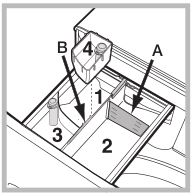
Compartment 1: Pre-wash detergent (powder)Before pouring in the detergent, make sure that extra compartment 4 has been removed.
Compartment 2: Washing detergent (powder or liquid)If liquid detergent is used, it is recommended that the removable plastic partition A (supplied) be used for proper dosage. If powder detergent is used, place the partition into slot B.
Compartment 3: Additives (fabric softeners, etc.)The fabric softener must not exceed the “max” level indicated on the central pin.
Extra compartment 4: Bleach
Bleach cycle
Insert the additional compartment 4 (provided) into compartment 1. In pouring the bleach do not exceed the “max” level indicated on the central pin.Perform bleaching by pouring the bleach into additional compartment 4 and set the programme .
! Traditional bleach should be used on resistant white fabrics, and delicate bleach for coloured and synthetics fabrics and for wool.
Preparing the laundry
- Divide the laundry according to:– the type of fabric/the symbol on the label– the colours: separate coloured garments from whites.
- Empty all garment pockets and check the buttons.
- Do not exceed the values listed in the “Table of wash cycles”, which refer to the weight of the laundry when dry.
How much does your laundry weigh?1 sheet 400-500 g1 pillow case 150-200 g1 tablecloth 400-500 g1 bathrobe 900-1.200 g1 towel 150-250 g
Special wash cycles
Sport (programme 1) is designed for washing lightly soiled sports clothing (tracksuits, shorts, etc.); for best results, we recommend not exceeding the maximum load indicated in the “Table of wash cycles”. We recommend using liquid detergent, and adding the amount suitable for a half-load.
Dark: use programme 2 to wash dark-coloured garments. This programme is designed to maintain dark colours over time. We recommend using a liquid detergent for the best results when washing dark-coloured garments. When you select the drying function, at the end of the washing cycle the machine will automatically perform a delicate drying cycle that preserves the colours of the garments. The display will show the level “ ”.Max. load: 3 kg.
Anti-odour: use programme 3 for washing garments with bad odours (e.g. smoke, sweat, fried food). The programme is designed to remove bad odours while preserving the fabric fibres. Synthetics fabrics or mixed loads should be washed at 40°, and resistant cotton fabrics at 60°.
Delicate: use programme 4 to wash very delicate garments. It is advisable to turn the garments inside out before washing them. For best results, use liquid detergent on delicate garments.
When selecting an exclusively time-based drying function, a drying cycle is performed at the end of the wash cycle that is particularly delicate, thanks to light handling and appropriate temperature control of the water jet.
The recommended durations are:1 kg of synthetic garments –> 150 min1 kg of synthetic and cotton garments –> 180 min1 kg of cotton garments –> 180 minThe degree of dryness depends on the load and fabric composition.
Wool: the wool wash programme of this machine has been tested and approved by The Woolmark Company for the washing of wool containing garments labelled as “hand wash” provided that the garments are washed according to the instructions on the garment label and those issued by the manufacturer of this washer-dryer.
(M1127) ![]()
In UK, Eire, Hong Kong and India the Woolmark trade mark is a Certification trade mark.
Rapid 30’ (programme 6) this programme is designed to wash lightly soiled garments at 30° (excluding wool and silk) with a 3 kg maximum load in a short time: it only lasts 30 minutes and allows for saving time and energy
Coloured: use this programme 10 to wash bright coloured clothes. The programme is designed to maintain bright colours over time.
Eco Cotton 20° (programme 11) ideal for lightly soiled cotton loads. The effective performance levels achieved at cold temperatures, which are comparable to washing at 40°, are guaranteed by a mechanical action which operates at varying speed, with repeated and frequent peaks.
Eco Synthetic (programme 12) ideal for mixed loads (cotton and synthetics) with a normal soil level. The effective performance levels achieved at cold temperatures are guaranteed by a mechanical action which operates at varying speed, across set average intervals.
Wash&Dry 45’ select programme 13 for washing and drying lightly soiled garments (Cotton and Synthetic) in a short time. This cycle may be used to wash and dry a laundry load of up to 1 kg in just 45 minutes. To achieve optimum results, use liquid detergent and pre-treat cuffs, collars and stains.
AirFresh (programme 14 ) ideal cycle to refresh garments and remove bad odours, in particular smoke, from cotton and synthetic items in 30’ (max 1.5kg) without the washing phase.
Load balancing system
Before every spin cycle, to avoid excessive vibrations before every spin and to distribute the load in a uniform manner, the drum rotates continuously at a speed which is slightly greater than the washing rotation speed. If, after several attempts, the load is not balanced correctly, the machine spins at a reduced spin speed. If the load is excessively unbalanced, the washer-dryer performs the distribution process instead of spinning. To encourage improved load distribution and balance, we recommend small and large garments are mixed in the load.
Troubleshooting
Your washer-dryer could occasionally fail to work. Before contacting the Technical Assistance Service (see “ Service”), make sure that the problem cannot be solved easily using the following list.
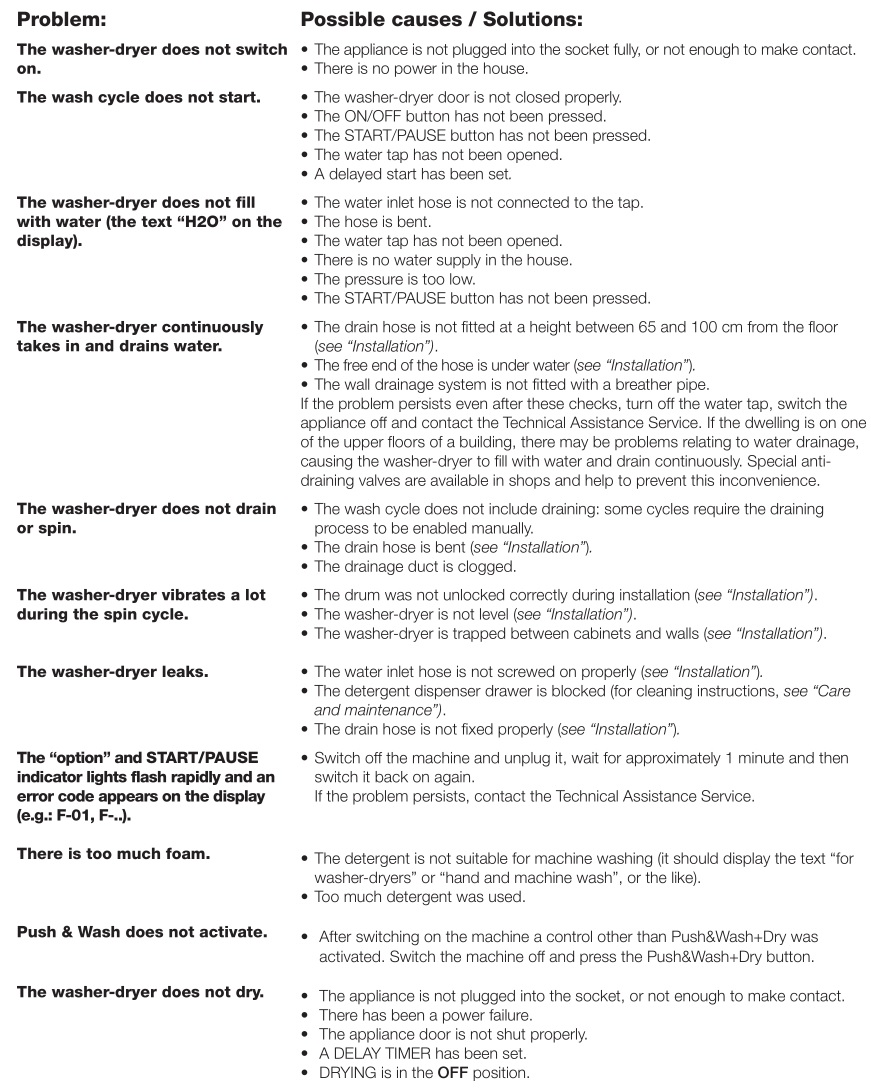
Service
Before contacting the Technical Assistance Service:
- Check whether you can solve the problem alone (see “Troubleshooting”).
- Restart the wash cycle to check whether the problem has been solved.
- If this is not the case, contact an authorised Technical Assistance Centre.
! Always request the assistance of authorised technicians.
Have the following information to hand:
- the type of problem;
- the appliance model (Mod.);
- the serial number (S/N).
This information can be found on the data plate applied to the rear of the washer-dryer, and can also be found on the front of the appliance by opening the door.
FAQS
We recommend the following: Ensure that the vent hose is not blocked or crushed. Ensure that your Indesit washer dryer is not being overfilled with clothing as this will impair the performance. Double check the heat switch on your dryer is set to the appropriate position.
To clean the door seal, we recommend using a damp cloth and a mild detergent. Do not use a hard brush or abrasive products as they may damage the seal.
This could be due to one of the following reasons:• A large amount of clothing has been loaded into the drum which has caused an imbalance in weight distribution;• A large amount of clothing has been loaded into the drum which has caused an imbalance in weight distribution;• A large amount of clothing has been loaded into the drum which has caused an imbalance in weight distribution;• There are items placed on top of or too close to the machine (for example, furniture);• There are items placed on top of
Excessive vibration can damage the appliance. And put additional stress on the drum and bearings. A blocked pump or hose may be the culprit here. Items of clothing can get stuck in the drainage system and clog the hoses leading to the pump and sometimes the pump itself.
Express Wash & Dry (wash cycle 13) was designed to wash and dry lightly soiled garments quickly. This cycle may be used to wash and dry a laundry load of up to 0.5 kg in just 35 minutes. To achieve optimum results, use liquid detergent and pre-treat cuffs, collars and stains.
A good airflow is the key for a dryer to work properly. If your clothes are still wet after a drying cycle it could mean that the Air Vent is clogged. To fix this problem, you will have to unplug the dryer and disconnect it from the vent. Once everything is disconnected, it’s time to vacuum the vent.
You can wash or dry independently, so you can use it as a normal washer with the peace of mind of a dryer for emergencies. Purchase and running costs are roughly equivalent to a separate front loading washer and condenser dryer.
Whirlpool announced this week that it is preparing to recall up to 519,000 Hotpoint and Indesit washing machines. The machines are being recalled owing to a fault with the door lock, which results in them posing a fire risk. The recall covers models manufactured between October 2014 and February 2018.
When it comes to overall efficiency, over the last 10 years, washers have become more efficient while dryer technology hasn’t changed significantly [source: Consumer Reports]. This means that some combo units can be more energy-efficient than two separate standard machines.
Press the “Start/Pause” button on the front of your washing machine and wait a few minutes for the washer to safely drain away water in the drum before it unlocks the door. Once this is done, you’ll be able to open the door and add/remove items or make chances to the cycle.
Typically, a gas or electric dryer should take about 30 to 45 minutes to dry a full load of clothes. Dense fabrics—like a quilt or a load of thick bath towels—may take up to an hour to dry. If your dryer’s taking too long to dry your laundry, it’s important to figure out what’s wrong instead of ignoring it.
Overloading can lead to an imbalance that reduces the washer’s spin speed, leaving clothes too wet after spin cycle completes. If the washer leaves clothes soaked after a large load, remove some items, redistribute others and run another rinse and spin cycle.
use the tumble dryer on a high heat setting. This is also the best option for those occasions when time is not on your side, and you suddenly end up with a muddy sports kit that must be cleaned for that morning’s football match.
Lint in debris buildup inside exhaust vents is a common cause of a dryer taking too long to dry. Clogged dryer vents can also restrict airflow in the dryer and lengthen drying times, not to mention cause dangerous dryer fires.
Clean the dryer vent and exhaust duct. Periodic cleaning prevents lint buildup, which would otherwise impede the airflow and increase dry time.Shorten the dryer hose.Remove lint from the filter screen.Shake water from your wardrobe.Don’t overload the dryer.Resist opening the door.Throw in the towel—literally.
A single bath towel put in the tumble dryer on its own should dry within 10-30 minutes, depending on the model of dryer and the heat settings. A full load of towels is likely to take at least an hour to dry in a tumble dryer.
Resolution. When a washing machine finishes a cycle sometimes water can remain in the drum where the machine hasn’t been able to drain it correctly. It is also worth draining the machine before cleaning the filter to stop water from leaking out onto the floor while you are cleaning it.
Washer dryers work hard to keep your clothes clean and fresh, so we’d recommend giving your washer-dryer a clean from time to time. Residues of softener, detergent and dirt may accumulate in your machine over time, causing some unpleasant odours.
We recommend using a powerful cleaner like Dettol Washing Machine Cleaner* in an empty wash to help remove bacteria, bad odour, hidden dirt, limescale and mould.
You can absolutely run a washing machine empty, and in fact, you should make a point of doing it regularly! If you want your washing machine to remain in peak condition, it’s important to keep it as clean as possible.
12 Bad Habits That Are Damaging Your Washer & Dryer
- You don’t empty your pockets.
- You put lingerie in the washer & dryer.
- You use too much detergent.
- You cram the washing machine too full.
- You leave wet clothes in the washing machine.
- You’re overloading your dryer.
- You’re overusing dryer sheets.
- You’re mixing items.
VIDEO

References
[xyz-ips snippet=”download-snippet”]

